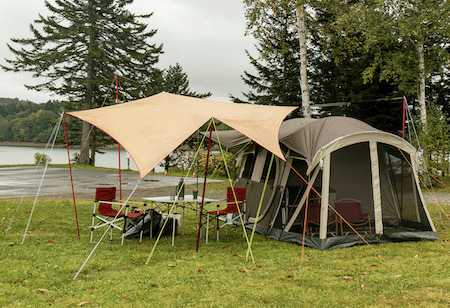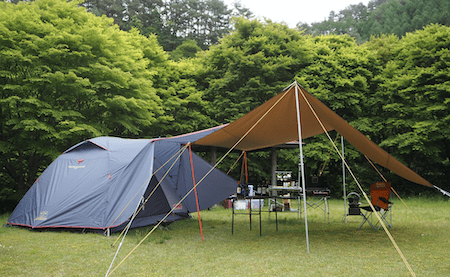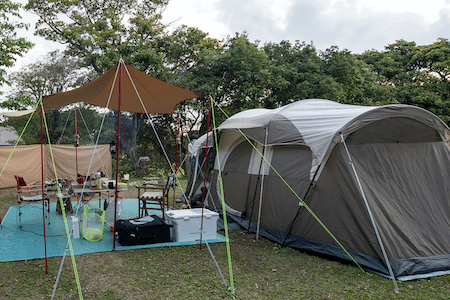Hanging a tarp over a tent creates a stronger shelter to save you from a downpour or stormy wind.
During downpours, it also can keep the area dry.
However, setting up a tarp over your tent requires some handy skills like knotting, and it becomes much easier when you have trees surrounding your camping area.
But, can you hang a tarp over a tent without trees?
Well, when you have no trees around, hanging a tarp over your tent can be difficult if you don’t know the ways.
No worries.
Here, we will talk about some effective ways so that you can quickly hang a tarp over your tent whenever the weather causes sudden inconvenience especially if there are no trees around.
Can You Hang A Tarp Over A Tent Without Trees?
Yes, you can, here are some effective ways to hang a tarp over your tent when there are no trees around.
But before we start, let’s learn about what equipment you will need for this setup:
Required Equipment
Tarp
A tarp is required for a tarp shelter. There are many multiple kinds of tarps, so do your homework to determine which one you will need.
Guy Ropes
Guy ropes are the most often used form of rope for tarps, tents, and camping shelters.
Stakes
Stakes are usually made of metal, wood, or plastic that are used to anchor the tarp to the soil. You don’t need to purchase additional as most of the tents come with stakes.
Poles
To hang your tarp up, you’ll require two metal poles or two extremely huge sticks.
Bungee Cord Balls
The bungee cords are ideal for attaching your tarp while also offering a little stretch to minimize potential tarp damage.
Well, it’s preferable to have your own poles, though you can always make them with a couple of huge and robust sticks.
But the only issue may come up if you need to locate shelter in a location where there are no sticks.
First, let’s imagine that you either have your poles or you managed one, or two solid sticks.
Now, we can begin the tarp setting journey:
#1. Set Up One Pole Tarp: (Closed-End A-Frame Shelter)
If you just have one pole, you’ll need to use your tarp to make a closed-end a-frame design.
Because with one pole, a closed-end frame shelter is the only way to go!
Steps To Set Up One Pole Tarp over Your Tent:
- Place your tarp on a flat or semi-flat surface.
- Attach the guy lines to all of your tarp’s corners.
- Stake the back guy line in place (don’t tighten it yet).
- Stake the two symmetrical guy lines further into the soil (do not tighten them yet).
- Now, Put your customizable pole in the tarp & fit it in the right place.
- Attach a guy line with the pole & tension it in the reverse direction as the rear guy line.
- Now, place this guyline in the desired spot and stake it into the ground.
- Well, you are now done with the process. Now check and modify the tension of all the other guy lines, to create a robust and safe shelter.
#2. Set Up Two Pole Tarp: (A-Frame Shelter)
If you got two poles with you for hanging your tarp over the tent, the “A-Frame” style is ideal.
This design is quite similar to a typical tent configuration, except that it is elevated above the ground.
To accomplish this height, make sure your guy line is taut and your poles are set to the proper height.
Steps To Set Up Two Pole Tarp over Your Tent:
- Tie the guy lines to each of your tarp’s corners.
- Now, stake the guy lines in the ground on one end of the tarp (not in the end in which the poles will go).
- Insert a guy line through one of your flexible poles and attach it to the tarp.
- Now, you should repeat this on the other side of the tarp.
- Pull all the guy lines tightly and stake all of them into the ground on the other end of the tarp.
- Finally, adjust all guy lines as needed around the tarp to ensure it is tight and secure.
Well, these are the two ways to hang a tarp over your tent when you have one, or two poles with you but no trees around.
#3. But What If You Don’t Have Any Poles?
If you don’t have any poles with you when you put up your tent, you have a few choices.
None of these are ideal, but they may provide adequate shelter for you:
- Instead of your metal poles, you have to use a stick or a branch. Just make sure that your sticks are long and sturdy.
- Now, place your sleeping arrangement on a flat surface and follow all the steps above with poles. Here you are using sticks instead of your poles.
- For height, use a mound of rocks. To perform this efficiently, you will require a lot of rocks. A wet stone wall will be ideal for this, although it may not give enough height above a tent.
So, these are the possible ways to hang a tarp over your tent when there are no trees around your camping area.
What Should You Know Before You Hang A Tarp Over Your Tent?
Before you go to hang a tarp over your tent, here are some aspects you must know in order to create a strong shelter:
Become Familiar With Your Knots
Whenever you will need to hang a tarp over your tent, you must know some special knotting in order to set up the tarp efficiently.
Well, the best knot to tie would be the Truckers Hitch along with a Slip Knot!
Other essential knots to learn are the Evenk Knot, Two Round Turns, and A Half Hitch knot.
So, before you go to hang a tarp over your tent, make sure you have learned the knots.
Guy Ropes And Stakes Are Important
Guy Lines and Stakes are the most crucial aspects in effectively making a pleasant tarp shelter.
Because, if you don’t know which are the right types of ropes to use, you can never make your tarp shelter durable.
On the other hand, stakes also play a huge role in keeping the tarp stable.
So when you are choosing your stakes, make sure they are long and sturdy enough to withstand heavy wind and your guy ropes are durable.
Never Leave Your Tarp With A Flat Place
When you are setting up your tarp over your tent, make sure you place your tarp maintaining a minimum angle over the tent.
Because, if you lay the tarp surface flat on the top end, water will pool on top & weigh it down.
It won’t be long before your tarp weighs enough just to pull the pegs out of the soil & totally remove them.
So, maintaining an angle would be ideal for a sturdy tarp setup.
Practice Before You Go Out
Once you have learned all the procedures don’t go camping before you practice all the lessons at home.
Because it needs the practice to become efficient in doing a task. Especially practice all the knots several times as forgetting the knots are so common when it’s needed.
So, make sure you are practicing how to hang a tarp over your tent with and without trees at home a minimum of 10 times.
This practice will increase your confidence.
Well, these are the most important aspects to keep in mind whenever you are going to set up a tarp over your tent without having trees around you.
How Do I Choose A Tarp For Camping?
When you are buying a new tarp for your shelter, there are a few aspects to keep in mind.
These are:
#1. Tarp Thickness
Your tarp must be strong enough to resist changes in weather.
When it comes to durability, a simple approach to discovering the ideal tarp is to look at the thickness and the sort of components used in its construction.
Tarp thickness is calculated in mils (1/1000 inch). It would be good to get for ordinary usages, such as covering goods, you should seek a portable blue tarp with a minimum thickness of 5 mils.
If you want to use the tarp for moving products or covering machinery equipment, you should seek a sturdy tarp with a thickness of at least 23 mils.
#2. Select The Appropriate Tarp Type
Tarps come in a variety of styles.
Choosing the right sort of tarp for your purposes is crucial. Here are the different types of tarps:
Poly Tarps
Poly tarps are the most widely purchased tarps. Polyethylene (Poly) tarp is a heavy-duty plastic tarp good for several applications.
It’s ideal for camping, house building, and renovation (for example, a roof cover), and also as a transient cover or shelter.
Its best advantage is that it is lightweight and absorbs almost no water, making it ideal for a variety of outdoor applications.
Canvas Tarps
These are made of extremely durable plain-woven fabric (cotton/hemp).
Canvas tarps are more costly than poly tarps though they last longer and can withstand more abrasions, making them ideal for tougher applications such as long-term building or painting projects, as well as roof or barn covers.
Canvas is also flame resistant.
Vinyl Tarps
Made from ethylene molecules, vinyl tarps are more durable than poly tarps and much more costly.
They are frequently used to cover vehicles, trailers and RVs, equipment, furniture, and other items.
The vinyl tarp is also an excellent long-term roof cover.
PVC Tarps
PVC tarps are extremely sturdy and flexible, making them an excellent choice for industrial applications such as floor coverings and welding curtains.
#3. Tarp Size
Size is a very important factor for a tarp. In general, you want a huge tarp that can provide adequate coverage, whether you’re using it to construct or cover a tent or to shade your vehicles.
Tarps, thankfully, come in a variety of sizes. Some tarp producers may even tailor the size to match the demands of the customer.
#4. Ease Of Using
Whether you’re erecting a temporary shelter or a tent, the simplicity of usage of a tarp is another crucial factor to consider when purchasing one.
Your tarp must be easy to use, otherwise, you will face many inconveniences.
To avoid the hassle, you should always look for tarps with grommets so that you can quickly install or connect them to where they are needed.
#5. Tarp Color
Whenever it comes to the color of a tarp, it is about more than just the appearance and style of the product.
It also refers to the tarp’s quality, type, and strength.
Among the most popular are the silver heavy-duty tarp, which effectively blocks sunshine, and the white tarp offers some shade while allowing natural light to pass through.
Tarps in blue, green, and brown are often employed in ordinary building or landscape maintenance, whereas red, yellow, and orange tarps are utilized in situations requiring strong visibility.
So, these are the major facts you can check out whenever you are buying a tarp.
Frequently Asked Questions
Can A Tarp Withstand A Lot Of Wind?
Yes! Tarps can endure a significant amount of wind.
A tarp would need a lot of wind to rip holes in it and it will not move as long as your stakes are securely planted in the ground.
Generally, a well-set-up tarp can withstand the wind that is blowing at 60 km per hour.
How Big Should Tarp Over Tent Be?
It is advisable to have a tarp with you that is slightly greater than the size of your tent or other sleeping arrangements.
Because, when you buy a tarp that has a larger size compared to your tent, it will cover an extra area during downpours which will help to keep the place dry.
Why Are Roof Tarps Blue?
The color blue is used to identify tarps as part of an unofficial color-coding scheme.
The blue tint usually denotes a tarp composed of coated polyethylene, which is waterproof, stretchable, UV proof, and tear-resistant.
Well, the blue color is not constant for a tarp, you will find a tarp in other colors as well.
Final Words
The ability to hang a tarp shelter over a tent without trees is an essential skill when you are camping for several weeks.
You can’t foretell how the weather will be!
In this discussion, we tried to explain how you can hang a tarp over a tent without trees so that you can protect yourself even in inconvenient weather conditions.
So, make sure you carry a tarp with you because having everything that you need to make a shelter in your bag will make your camping more enjoyable in the wilderness.



